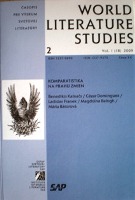Porovnávacia literatúra a umelecký preklad
COMPARATIVE LITERATURE AND ARTISTIC TRANSLATION
Author(s): Ladislav FranekSubject(s): Literary Texts
Published by: SAV - Slovenská akadémia vied - Ústav svetovej literatúry
Keywords: Comparative Literature; Interdisciplinarity; Polymorphism of Literature; Formal and Structural Method; Semiotics; Translation Criticism; Interdisciplinarity in the Pedagogical Process
Summary/Abstract: In the beginning of the paper Franek characterizes the fundamental features of comparative literature since its formation. He understands the discipline as a complex interdisciplinary area of cognition, whose uniqueness stems from the affiliation to systematism as well as from the instability of criteria, of terminology and valid norms. In order to provide an example of a multilateral approach, the author summarizes the research by the Cuban scholar C. Suárez León about the influence of V. Hugo on J. Martí’s ideo-aesthetic concept of universality. Franek emphasizes the bond between Marti and the Hispanic American continent, which is also reflected in Marti’s thoughts about his own translations of Hugo’s work. In the next part of the paper Franek focuses on the theoretical heritage of Slovak comparative literary studies (D. Ďurišin) and of historical poetics (M. Bakoš). In Slovakia the work of M. Bakoš is considered the first important step towards interdisciplinarity. The author simultaneously draws the attention to the violent interruption of the intraliterary research in the development of national literatures at the beginning of the 1970s. Franek, familiar with Ďurišin’s theory, deepens and broadens Ďurišin’s comparative approach in his own interliterary analysis of Slovak translations from French poetry (as in his book The Style of Translation). Besides M. Bakoš’s formal method, Franek finds inspiration in the structural poetics of J. Cohen, which is enriched by the phonosemantic point of view. The author demonstrates the fruitful use of semiotics in comparative research on the example of the polysemy of Romanian languages. Franek sees the solution for the bilateral monitoring of the interliterary process in the exceeding of the formalistic attention to the reality of one language and one literature. He leans on the significant role of Slovak criticism of artistic translation (J. Felix), which has developed in Slovakia more than in Western countries. On this basis, Franek revaluates Ďurišin’s unequal relationship between the received and the receiving literary context. In concordance with the ideas of the Spanish comparatist C. Guillén in his book Entre lo uno y lo diverso (Between the One and the Diverse), Franek accentuates the need for a critical-analytical approach to literary texts, and especially so in connection with the translated literature. As far as the pedagogical purposes are concerned, Franek, with the emphasis on students’ own creativity, argues for the interconnectedness of theory and practice and for the complex effect of the discipline (literary history, stylistics, literary translation) in the teaching process. The developments in modern and postmodern literature have been increasingly influencing this interdisciplinary method by multicultural symbiosis. Thanks to this, concludes Franek, the comparative literature does not lose its original human dimension and importance even today.
Journal: World Literature Studies
- Issue Year: I/2009
- Issue No: 2
- Page Range: 25-41
- Page Count: 17
- Language: Slovak

